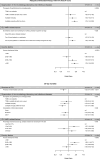The role of centre and country factors on process and outcome indicators in critically ill patients with hospital-acquired bloodstream infections
- PMID: 38498170
- PMCID: PMC11164726
- DOI: 10.1007/s00134-024-07348-0
The role of centre and country factors on process and outcome indicators in critically ill patients with hospital-acquired bloodstream infections
Erratum in
-
Correction: The role of centre and country factors on process and outcome indicators in critically ill patients with hospital-acquired bloodstream infections.Intensive Care Med. 2024 Jun;50(6):1017-1018. doi: 10.1007/s00134-024-07415-6. Intensive Care Med. 2024. PMID: 38587556 Free PMC article. No abstract available.
Abstract
Purpose: The primary objective of this study was to evaluate the associations between centre/country-based factors and two important process and outcome indicators in patients with hospital-acquired bloodstream infections (HABSI).
Methods: We used data on HABSI from the prospective EUROBACT-2 study to evaluate the associations between centre/country factors on a process or an outcome indicator: adequacy of antimicrobial therapy within the first 24 h or 28-day mortality, respectively. Mixed logistical models with clustering by centre identified factors associated with both indicators.
Results: Two thousand two hundred nine patients from two hundred one intensive care units (ICUs) were included in forty-seven countries. Overall, 51% (n = 1128) of patients received an adequate antimicrobial therapy and the 28-day mortality was 38% (n = 839). The availability of therapeutic drug monitoring (TDM) for aminoglycosides everyday [odds ratio (OR) 1.48, 95% confidence interval (CI) 1.03-2.14] or within a few hours (OR 1.79, 95% CI 1.34-2.38), surveillance cultures for multidrug-resistant organism carriage performed weekly (OR 1.45, 95% CI 1.09-1.93), and increasing Human Development Index (HDI) values were associated with adequate antimicrobial therapy. The presence of intermediate care beds (OR 0.63, 95% CI 0.47-0.84), TDM for aminoglycoside available everyday (OR 0.66, 95% CI 0.44-1.00) or within a few hours (OR 0.51, 95% CI 0.37-0.70), 24/7 consultation of clinical pharmacists (OR 0.67, 95% CI 0.47-0.95), percentage of vancomycin-resistant enterococci (VRE) between 10% and 25% in the ICU (OR 1.67, 95% CI 1.00-2.80), and decreasing HDI values were associated with 28-day mortality.
Conclusion: Centre/country factors should be targeted for future interventions to improve management strategies and outcome of HABSI in ICU patients.
Keywords: Bacteraemia; Centre; Hospital-acquired bloodstream infections; Outcome indicator; Process indicator.
© 2024. The Author(s).
Conflict of interest statement
NB received a Mobility grant from the Swiss National Science Foundation (Grant number: P400PM_183865). JJDW is a senior clinical investigator funded by the Research Foundation Flanders (FWO, Ref. 1881020N). ACM is supported by a Medical Research Council Clinician Scientist Fellowship (MR/V006118/1) and received speaking fees from Fischer & Paykel, Biomerieux; he participated in scientific advisory board of Cambridge infection diagnostics; he received support for the present manuscript by the medical research council (Clinician Scientist Fellowship grant number: MR/V006118/1). ML received consulting fees from LFB, Shionogi, AOP Pharma and Viatris outside of this project. RF has received consulting fees from Inotrem, Pfizer and Cytosorbent and honoraria for lectures from Shionogi, MSD, Menarini, Thermofisher and Gilead. GM received payment for honoraria for lectures, presentations, speakers bureaus, manuscript writing or educational events from Thermofisher, Gilead, Pfizer and 3 M; and she participated on a data Safety Monitoring Board or Advisory Board by Gilead and 3 M. AC received fees for lectures and scientific consultancies by Gilead, MSD, Mundipharma, Pfizer. LDB participated on data safety monitoring or advisory board of MSD. MB received payment or honoraria for lectures, presentations, speakers bureaus, manuscript writing or educational events from Angelini, Biomerieux, Cidara, Gilead, Menarini, MSD, Pfizer, and Shionogi. MB participated on data safety monitoring board or advisory board of Angelini, Biomerieux, Cidara, Gilead, Menarini, MSD, Pfizer, and Shionogi. MA participated on a data safety board for GSK and is the president of the International Immunocompromised Host Society.
Figures

References
-
- Cassini A, Plachouras D, Eckmanns T, Abu Sin M, Blank HP, Ducomble T, et al. Burden of six healthcare-associated infections on european population health: estimating incidence-based disability-adjusted life years through a population prevalence-based modelling study. PLoS Med. 2016;13(10):e1002150. doi: 10.1371/journal.pmed.1002150. - DOI - PMC - PubMed
-
- Cassini A, Colzani E, Pini A, Mangen MJ, Plass D, McDonald SA, et al. Impact of infectious diseases on population health using incidence-based disability-adjusted life years (DALYs): results from the Burden of Communicable Diseases in Europe study, European Union and European Economic Area countries, 2009 to 2013. Euro Surveill Bull Eur Malad Transm Eur Commun Dis Bull. 2018;23(16). - PMC - PubMed
Publication types
MeSH terms
Substances
Grants and funding
LinkOut - more resources
Full Text Sources

